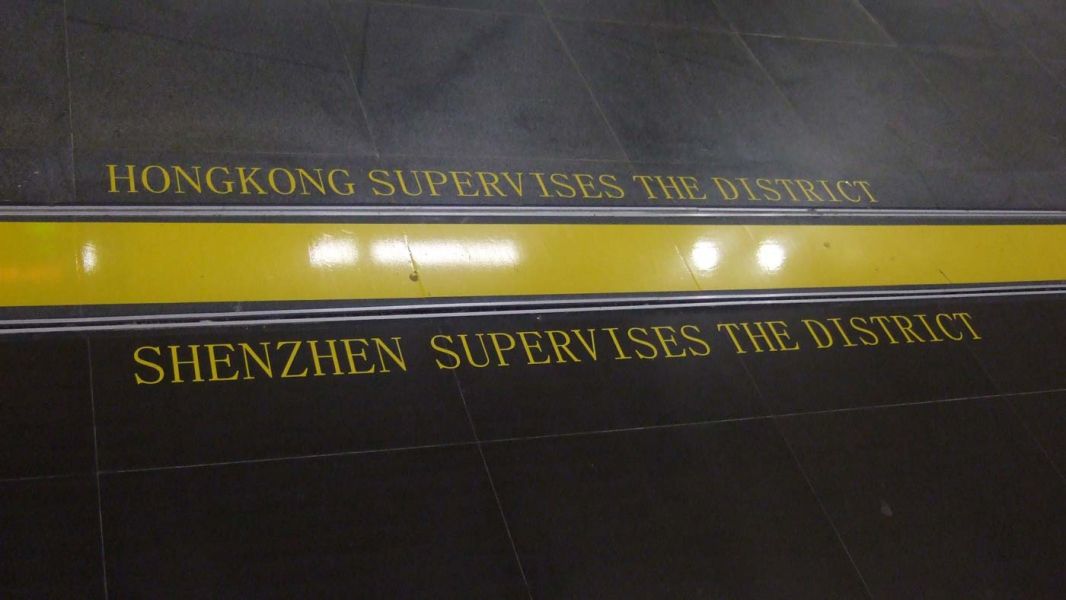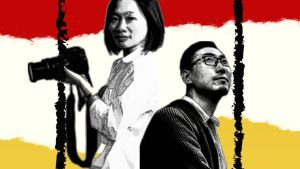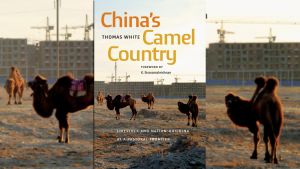
Narrating Mobility as an Achievement on the Shenzhen–Hong Kong Border
‘Where are you from?’
Whenever this question is asked in Shenzhen, the usual expectation is that you will not hear ‘Shenzhen’ as a response. Rather, it is widely assumed that almost everyone is from somewhere else. As its nickname, ‘city of immigrants’ (移民城市), suggests, Shenzhen is widely regarded as a migrant-receiving destination. Mobility and migration no longer imply the ‘illegality’ they once did (de Genova 2002) and have been reconfigured as the key themes in the narratives of growth and flourishing in the city. At the municipal level, it is the arrival of migrant-labourers and investments from overseas Chinese that has allowed the metropolis to grow. At a personal level, people often describe their arrival in the city with empty hands as a life-changing event, from which their current achievements stem.
What amplifies Shenzhen’s narratives of mobility are its proximity to Hong Kong and the hypermobility of the Shenzhen–Hong Kong border zone. Many scholarly works in various disciplines from both sides of the border have presented numerous accounts of stowaway migrants, cross-border families, policy exchanges, and the enormous volume of licit and illicit traffic in humans and goods between the two territories (see, for instance, Du 2020; Huang 2017; Lin and Tse 2005; Ma and Blackwell 2017; O’Donnell 2001). The characterisation of the border as porous and unpredictable allows for the description of the city as a liminal zone that leads to a world beyond the border—an understanding that is reflected not only in everyday conversation, but also in policy experimentations that have taken place in Shenzhen (O’Donnell et al. 2017).
Previous research compellingly demonstrates that mobility in post-Mao China has turned into ‘the principle and modus operandi for value production’ (Chu 2010: 10) and plays a significant role in defining identities (see, for example, Ong 1999). As Julie Chu (2010) shows in her ethnography of Fuzhounese transnational migration, even those who appear socially and legally to be peasants from rural backwaters overflow with cosmopolitan aspirations. They accept mobility as a ‘condition of everyday life’ and a ‘practice to strive for’ (Chu 2010: 10), whereas they experience immobility as a form of displacement and even a moral disgrace. In this essay, I elaborate on this insight by examining how cross-border mobility operates in Shenzhen—a liminal zone that can be characterised as both a destination and a corridor for further exits. In particular, I examine the structure of discourse that renders mobility a morally salient defining feature of Shenzhen identity.
Understanding Cross-Border Mobility through the Two-Way Travel Permit
Yilin moved into Shenzhen soon after graduating from a college in one of the provinces neighbouring Guangdong. After this move, she spent most of her twenties struggling to make ends meet, returning only occasionally to her hometown. During these years, her household registration (户口, hukou) remained in her place of origin. It was only six years after Yilin had first set foot in Shenzhen that she finally decided to apply for a Shenzhen household registration and become a legal permanent resident. When she disclosed this decision, I asked what had prompted her to make such a move. Instead of giving a clear answer, she mumbled a list of possible reasons, including the fact that permanent residence in Shenzhen comes with a special Hong Kong travel permit. She was referring to the well-known regulation that allows Shenzhen’s permanent residents to make frequent trips over the border: their Exit–Entry Permits for Travelling to and from Hong Kong and Macau (往来港澳通行证) do not expire after one or two trips. I found her answer startling because she had rarely, if ever, expressed strong interest in travelling to or living in Hong Kong. When I asked what she found attractive about the travel permit, she alluded to some generic impressions of Hong Kong, and made little effort to make her answer particularly convincing. I did not push her for further clarification, since I was aware that she had been undergoing a sort of quarter-life crisis while trying to establish her future plans—just like many young people I have encountered in Shenzhen.
Yilin’s invoking of the Hong Kong travel permit is interesting in several aspects. First, it captures the way mobility can be articulated not only through materialised movements, but also through promissory ones that may be enacted at a later point. The Exit–Entry Permit, also known as the two-way permit, endorses the permit-holder to exit mainland China and enter Hong Kong or Macau through designated ports. Although the permit is likely to deliver on its promise and grant border access in most cases, its efficacy is ultimately subject to border checkpoint policies, political circumstances, and numerous other elements. For example, Hong Kong’s COVID-19 travel measures practically invalidated many two-way permits, as their duration of stay falls short of the mandatory 14-day quarantine period (see also the notice on withholding the processing of permits: Shenzhen Municipal Public Security Bureau 2020). Considering the inherently uncertain nature of the permit, Yilin’s account projects an idea of mobility that takes a subjunctive form, demonstrating the broad scope of experiences of migration and mobility.
Second, Yilin’s account highlights the arbitrariness and inequality in how the border filters legitimate movement. While it is obvious that borders operate to generate different types of movement, what is peculiar here is the way the entitlement to cross the border is associated with the Chinese household registration system. Although the paperwork for the permit is known to be fairly straightforward, eligibility and application procedures are individualised based on one’s legal and social status. The two-way travel permit for Hong Kong and Macau is endorsed by the Public Security Bureau in mainland China, and issuance of the permit for individual travel is limited to permanent residents of specific areas designated by the State Council. With the exception of Guangdong Province, the State Council lists 28 major cities in China, such as Beijing, Shanghai, Nanjing, Chengdu, Kunming, and Xiamen (National Immigration Administration 2019). A finer distinction is made for Shenzhen permanent residents, who can enter Hong Kong every seven days within the permit’s period of validity through one of Shenzhen’s exit and entry ports, which have expanded in number and services, most recently with the establishment of the West Kowloon Station control point at the newly built Express Rail Link (for a full list of border checkpoints, see Hong Kong Immigration Department 2020). Those who are not legally registered in the listed areas must join a group tour and follow a stricter protocol in choosing their transportation to make a leisurely trip to Hong Kong.
Moreover, it is notable that one of the key obstacles that mainland Chinese face in accessing Hong Kong is their restricted ability to make a legitimate exit from mainland China. Hong Kong border authorities have the capacity to refuse entry to mainland Chinese residents, as exemplified by the rigorous surveillance of pregnant Chinese women. However, despite the travel permit’s usage as a de facto landing permit, it is primarily managed by the mainland Chinese authorities. The peculiarity of the arrangement of Hong Kong travel permits stands out even more when compared with the travel documents required for Taiwan, which include not only the Taiwan travel permit (commonly known as 台湾通行证) issued by the Public Security Bureau of the People’s Republic of China, but also the exit and entry permit (commonly known as 入台證) issued by the National Immigration Agency of the Republic of China (see National Immigration Administration 2020; National Immigration Agency 2020). Such an emphasis on filtering exits is rather unusual in the contemporary world, where most state authorities assert their monopoly over legitimate movements at entry rather than exit points. It is worth noting here that control of entrances is a relatively recent practice that proliferated globally only in the past century (McKeown 2008; Torpey 2000).
The two-way travel permit for Hong Kong and Macau provides blatantly differentiated treatment among mainland Chinese citizens, raising an interesting conceptual challenge to the way citizenship and equality are linked to border practices. According to McKeown (2008), exclusion and equality are the two pillars that uphold what we now imagine as common border surveillance practices. He argues that the global system of migrant identification and control, which began developing only in the late nineteenth century, asserts that ‘civilised’ countries deserve self-rule. Here, civilisation is measured against the degree of equality and rule of law that a country is believed to have achieved within its territory. It is this principle of self-rule and the language of civilisation that ideologically justify states wielding arbitrary power at the border to exclude non-citizens. This enables states to bring together a jarring combination of exclusion and equality without having to abandon liberal idealism (McKeown 2008: 1–15). Contrary to this globalised ideological formula, however, the two-way travel permit represents a form of inequality among mainland Chinese citizens based on their registered status—a status that people are born into. Moreover, given how Hong Kong citizens have more or less unlimited access to mainland China through their ‘Home Return Permit’ (see Laidler and Lee 2015), the travel permit system reveals a lack of reciprocity among different jurisdictional authorities in the borderland.
Overall, the two-way travel permit appears to suggest the exceptional character of the Shenzhen–Hong Kong border zone, which does not fall neatly in line with common practices at other international borders. After all, the border zone is exceptional in that the One Country, Two Systems policy has shaped the territorial landscape. Or perhaps it is the exceptional character of the so-called Socialism with Chinese Characteristics that defies the liberalist ideals that undergird the global system described above. However, despite all of these exceptionalities, the border zone extends to a historically constituted and globally shared discursive structure that assigns particular moral values to mobility.
Simulating Mobility as an Achievement
In Hong Kong Cantonese, the word noidei (内地, neidi in Mandarin) is a neutral term that indicates what lies across the border—that is, mainland China. It is at the Shenzhen–Hong Kong border that noidei begins; and this is where the rule of law, freedom, nonviolence, and all other values cherished by Hong Kong society as the core of its identity are understood to stop short (see Chang 2003, 2016; Newendorp 2011). Under this formulation, Shenzhen is rarely, if ever, distinguished from the rest of mainland China in any meaningful way. Shenzhen has been viewed as a gateway to the oppressive, authoritarian noidei regime. Decades before the kidnapping of the Causeway Bay bookstore owners in 2015, or the Handover in 1997, people in Hong Kong referred to Shenzhen with two characters that had the same pronunciation as the name of the city in Cantonese: samzan (心震)—a place that strikes fear into one’s heart. In Shenzhen’s colloquial Mandarin, however, neidi is often said to start from the outskirts of Shenzhen’s Special Economic Zone rather than at the Shenzhen–Hong Kong border. Although neidi can be interpreted as ‘inner regions’—in contrast to coastal areas—the characteristics claimed by Shenzhen suggest otherwise. Shenzhen’s self-characterisation presents a striking overlap with the extant discourse on Hong Kong’s identity (Chang 2017). Examples include describing Shenzhen as a place with more transparent bureaucratic and legal practices than the rest of mainland China, as a more open-minded and diverse city of immigrants, as a giant international metropolis that grew out of a small fishing village, and as an economically flourishing hub. The long list even includes the problematic epithet ‘cultural desert’ (文化沙漠) (Erni 2001; Cartier 2008).
This striking simulacrum effect allows Shenzhen to establish a temporal order that projects Hong Kong doubly as both its past and its future. Shenzhen perceives Hong Kong as having reached Shenzhen’s own goal of modernity and prosperity; and, at the same time, it domesticates Hong Kong into the regional past through the language of preservation and tradition (O’Donnell 2001). According to O’Donnell, ‘these complimentary displacements … [are what] produce a nostalgia peculiar to ShenKong: a desire for a past that entitles contemporary Shenzhen residents to Hong Kong’s prosperity’ (2001: 425–26). Such a configuration leads to a linear, if not teleological, trajectory, projecting Shenzhen as a halfway point—literally a special (economic) zone—that the rest of mainland China must pass through in the historical arc of modernisation and development. This linear trajectory corresponds to the widely circulating idea of civilisation or civility (文明), which is understood as measurable in terms of quality (素质), degree of modernisation, discipline, and so on (Anagnost 1997: 75–76). It is similar to the civilisation discourse that McKeown describes in that it enacts a critical evaluation of where society stands vis-a-vis the world.
This temporal order, which is established through collective reconstruction of memories and history, buttresses a moral understanding of how movements should be made in terms of their direction and tempo. Furthermore, the discourse of civilisation identifies human efforts and achievements as among the main driving forces of such movement. As mentioned earlier, Shenzhen’s official narrative often attributes its speedy developmental success—that is, the ‘Shenzhen miracle’ (深圳奇迹)—to the arrival of labour and overseas capital, both of which invoke hardworking Chinese pioneers. Tales of migrant labourers—including not only domestic migrant workers, but also the overseas Chinese who were once migrant labourers themselves—are studded with stories of visionary heroes who displayed courage and cleverness under the most unlikely circumstances (for example, O’Donnell 2017), and with numerous accounts of people working overtime with diligence, speed, and efficiency to support their family and better their lives (for example, Huang 2017: 65–66; Pun 2005: 77–108). In short, it was not some inevitable destiny, but rather remarkable human effort and hard labour, that moved Shenzhen at miraculous speed towards the prosperity and modernity that Hong Kong projects.
This morally binding logic of movement extends to Shenzhen’s discourse on citizenship. The city’s most well-known slogan, ‘Once you come, you are a Shenzhener’ (来了就是深圳人), gestures to the city’s openness and diversity. However, many of my interlocutors, including Yilin, noted that they do not feel they belong to the city. Their life accounts suggest that, rather than an entitlement granted by physical arrival, membership in the city is an achievable status, which might be gained through hard work and effort, and especially through education. This assumption is reinforced by the city’s permanent residence system, which not only filters potential member-candidates through minimum requirements of education or financial status, but also rewards qualified ‘human talent’ (人才) of certain education level or occupational background with immediate perks such as cash payments. While the city’s legal membership program allows both the city and interested people to maintain forward momentum, it underlines the socioeconomic inequalities into which each person is born. A failure to maintain mobility towards and beyond Shenzhen—legally, financially, or socially—is understood as testifying to a lack of effort on the part of the individual. In other words, portraying mobility as an achievement justifies the city’s high demands on its aspiring residents and the lack of reciprocity accorded to those who do not make it over the threshold.
It is this portrayal of mobility as an achievement that dominates the mobility regime in the Shenzhen–Hong Kong border zone. Rather than a natural human right for fellow compatriots, cross-border mobility is a perk that comes with Shenzhen membership—membership that is tied to the broader legal citizenship system in the household registration system. Moreover, as an achievement, mobility is naturalised as inherently good and morally desirable. Through an identification system that issues endorsements such as the two-way permit, mobility becomes a sign indexing people’s moral value (Chu 2010). It is within the context of this moral significance that Yilin’s earlier remarks revealing her somewhat uncertain desire for a two-way permit become more intelligible: Hong Kong remains an abstract sign that does not require concrete understanding, and a hypothetical destination that fuels the desire to maintain mobility.
Exits
After Yilin obtained her Shenzhen permanent residency, I interviewed her over an afternoon snack at the Café de Coral, a Hong Kong–brand fast-food restaurant. During our conversation, she remarked that she did not find Hong Kong particularly attractive. Recalling our past conversation, I asked what had happened to her interest in the two-way travel permit. Laughing, she answered that over the past few months, she had undergone a transformation in her mindset and was no longer prioritising material values. This change had led to her diminishing interest in Hong Kong, since Hong Kong is a material society (物质社会) that does not offer much other than shopping.
During my stay in Shenzhen, many people spoke of Hong Kong in a way similar to Yilin’s description. While some interlocutors continued to express optimism and enthusiasm about Hong Kong, others said the city was great only for food and shopping. Some even argued that life in Shenzhen was better, referencing the heavily publicised photos of ‘coffin homes’, snobby attitudes, and discriminatory behaviours of Hong Kong people towards mainland Chinese, as well as the fact that some Hong Kong permanent residents chose to reside in or frequently visit Shenzhen. These doubts about the value of cross-border mobility were further solidified when the anti–extradition law protests broke out in June 2019. Some Shenzhen residents blamed the protestors for making Hong Kong chaotic, while others blamed the incompetency of the Hong Kong Government for mismanaging its economy and making young people so desperate as to pour on to the streets. Very few people brought up the question of Hong Kong’s identity— a topic that seems mostly unrecognised, if not too sensitive to raise. Whatever the diagnosis was, it appeared that there was increasing disillusion with Hong Kong, and a derailment of the city from the place it had held on the linear development narrative.
If indeed Hong Kong is losing its attraction as a destination, Shenzhen and its people will have to reconfigure the linear trajectory along which their city was imagined to be moving. But what will a different trajectory look like, and what will be needed to make such a reconfiguration? President Xi Jinping’s recent speech in Shenzhen in celebration of the Special Economic Zone’s fortieth anniversary highlights integrated regional economic growth as the goal (Xi 2020). While the vision presents increased opportunities for some, it raises doubts and bitterness for others, including those who have been agonising over the possibility of making an exit from mainland China or Hong Kong. Whether purposeful or not, what is missing from the popular conversation is the potential vulnerability of Shenzhen’s heavily depoliticised identity—one that was crafted in the image of Hong Kong. In Hong Kong, the Occupy Central Movement, the anti–extradition law protests, and the more recent controversy over the National Security Law all demonstrate the untenability of endorsing values that lack rigorous examination of and wide reflection on their meanings and implications (Chang 2016). No matter how much positivity radiates from values such as economic growth, rule of law, openness, transparency, democracy, and innovations, they cannot prevail without substantiation by alignment with other moral values in ways that are meaningful to people’s lives and political identities. In fact, amid the ongoing celebration of Shenzhen’s growth and development, people like Yilin, now equipped with Shenzhen permanent residency, have already begun to question the value that Shenzhen membership can offer, and even to consider leaving the city altogether.





